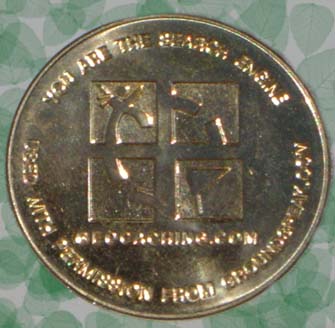Please re-hide this cache with proper
camouflage. Located off a well worn deer trail in Lebanon Hills
Regional Park. Park in lot off of Cliff Road near Schulz Beach for
shortest access. Path to cache will vary in length depending on
which "Trail Closed" signs are in effect that day. There is heavy
tree cover and we took an averaging of locations to pinpoint this
cache. Good Luck.

Historical
Information Regarding the "Real Fort Knox"
Fort Knox Bullion
Depository
A large amount of the United States' gold reserves is stored in
the vault of the Fort Knox Bullion Depository, one of the
institutions under the supervision of the Director of the United
States Mint. The remaining gold reserves are held in the
Philadelphia Mint, the Denver Mint, the West Point Bullion
Depository and the San Francisco Assay Office, also facilities of
the United States Mint.
The Depository was
completed in December 1936 at a cost of $560,000. It is located
approximately 30 miles southwest of Louisville, Kentucky, on a site
which was formerly a part of the Fort Knox military reservation.
The first gold was moved to the Depository by railroad in January
1937. That series of shipments was completed in June
1937.
The two-story basement
and attic building is constructed of granite, steel and concrete.
Its exterior dimensions measure 105 feet by 121 feet. Its height is
42 feet above ground level. The building's construction was
supervised by the Procurement Division of the Treasury Department,
now the Public Buildings Administration of the General Services
Administration. Upon its completion, the Depository was placed
under the jurisdiction of the Director of the United States
Mint.
Within the building is
a two level steel and concrete vault that is divided into
compartments. The vault door weighs more than 20 tons. No one
person is entrusted with the combination. Various members of the
Depository staff must dial separate combinations known only to
them. The vault casing is constructed of steel plates, steel
I-beams and steel cylinders laced with hoop bands and encased in
concrete. The vault roof is of similar construction and is
independent of the Depository roof. Between the corridor encircling
the vault and the outer wall of the building is space used for
offices and storerooms.
The outer wall of the
Depository is constructed of granite lined with concrete.
Construction materials used on the building included 16,500 cubic
feet of granite, 4,200 cubic yards of concrete, 750 tons of
reinforcing steel and 670 tons of structural steel.
Over the marble
entrance at the front of the building is the inscription "United
States Depository" with the seal of the Department of the Treasury
in gold. Offices of the Officer in Charge and the Captain of the
Guard open upon the entrance lobby. At the rear of the building is
another entrance used for receiving bullion and
supplies.
At each corner of the
structure on the outside, but connected with it, are four guard
boxes. Sentry boxes, similar to the guard boxes at the corners of
the Depository, are located at the entrance gate. A driveway
encircles the building and a steel fence marks the boundaries of
the site.
The building is
equipped with the latest and most modern protective devices. The
nearby Army Post provides additional protection. The Depository is
equipped with its own emergency power plant, water system and other
facilities. In the basement is a pistol range for use by the
guards.
The gold stored in the
Depository is in the form of standard mint bars of almost pure gold
or coin gold bars resulting from the melting of gold coins. These
bars are about the size of an ordinary building brick, but are
somewhat smaller. The approximate dimensions are 7 x 3-5/8 x 1-3/4
inches. The fine gold bars contain approximately 400 troy ounces of
gold, worth $16,888.00 (based on the statutory price of $42.22 per
ounce). The avoirdupois weight of the bars is about 27-1/2 pounds.
They are stored in the vault compartments without wrappings. When
the bars are handled, great care is exercised to avoid abrasion of
the soft metal.
The Depository is
headed by an Officer in Charge, who is responsible for ensuring the
security of the gold. The guard force is composed of men selected
from various Government agencies, or recruited from Civil Service
registers.
No visitors are
permitted at the Depository. This policy was adopted when the
Depository was established, and is strictly enforced.
